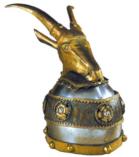 |
Here is some information regarding the helmet: Scanderbeg's helmet and Sword in Austrian Museum |
| HOME | CUSTOM WORK | HELMS | ARMS & HANDS | TORSO | LEGS | CHAIN-MAIL | ITEMS IN STOCK | LINKS | ORDER FORM |
| Text | Pictures of helmet at different stages of construction | Pictures of the finished helmet |
 |
Here is some information regarding the helmet: Scanderbeg's helmet and Sword in Austrian Museum |
Gjergj Kastrioti surnamed Scanderbeg (1405-1468), the national hero of Albania who united hitherto warring Albanian feudal clans into an effective armed alliance against invading Ottoman Turks for some 25 years, was noted for his military genius. His repeated defeats of overwhelmingly larger Ottoman forces were attributed to his first-hand knowledge of Turkish military tactics and his brilliant leadership and battle strategies. Yet, all that remain of Scanderbeg's personal military armament are his helmet and sword which are now preserved in the Kunsthistorisches Museum in Vienna, Austria.
How Scanderbeg's personal belongings turned up in Vienna so far away from his native land of Albania is attributed to the 16th Century Archduke Ferdinand II of Tirol and, especially, his secretary, Shrenke.
In 1567, Archduke Ferdinand went to Insbruk, the capital of Tirol (which he had inherited from his father) to restore Ambras castle. The Archduke, with renke's help, wrote letters to the outstanding personages of the period and to the heirs of those deceased requesting military arms, clothing, pictures, biographies, and other artifacts for exhibition in the armory of Ambras castle.
The first mention of Scanderbeg's sword and helmet was in a letter dated October 15, 1578, from the Duke of Urbino to Archduke Ferdinand stating that he could send the helmet and sword to Ambras.
In 1605, Ambras castle including the armory was sold to the Austrian Emperor where Scanderbeg's sword and helmet remained until 1806 when they were transferred with the rest of the military artifacts collection to Belvedere castle and finally, in 1888, to the Kunsthistorisches Museum in Vienna where they have remained on display to the present day.
It is believed that Scanderbeg's helmet and sword were brought to Italy by his wife and son and other members of his family who had emigrated to Italy after Scanderbeg's death in 1468 where they were eventually acquired by the Duke of Urbino.
The museum where Scanderbeg's helmet and sword are currently on exhibit is:
Kunthistorisches Museum 1010 Wien,
Neue Burg Vienna, Austria
Tel: 525 24 / 460 -- Fax: 523 77 50
The above is rewritten from an English translation
of the original Albanian on PP 76-77, "Shkenca dhe Jeta", Nr. 4,1989. Frosina
thanks Dr. Matthias Pfaffenbichler of the Kunthistorisches Museum for the
photos and museum catalogue information, Connie Christo for providing Austrian-to-English
translations, and Marjorie Senechal for the infobit idea.
Ceremonial Helmet
Italian, circa 1460 Bright steel, bells of
Italian design. Lower border and neck protection removed where corrosion
and cracks have
appeared. These have been covered by a sown-in
leather band under which the former coverlet of gold silk remains. Adjusted
copper
headstrap bound by gold ornamental borders
decorated with six rosettes of which the copper gilt original is in the
neck - the remaining
five are restorations of the 16th century.
Between the rosettes inscription: in/per/ra/to/re/bt. helmet ornament in
the form of a goat's
head of embossed, engraved gilt sheet copper
with gilt ornamental border. A hole in the helmet originally served for
fastening Scanderbeg's crest.
| HOME | CUSTOM WORK | HELMS | ARMS & HANDS | TORSO | LEGS | CHAIN-MAIL | ITEMS IN STOCK | LINKS | ORDER FORM |